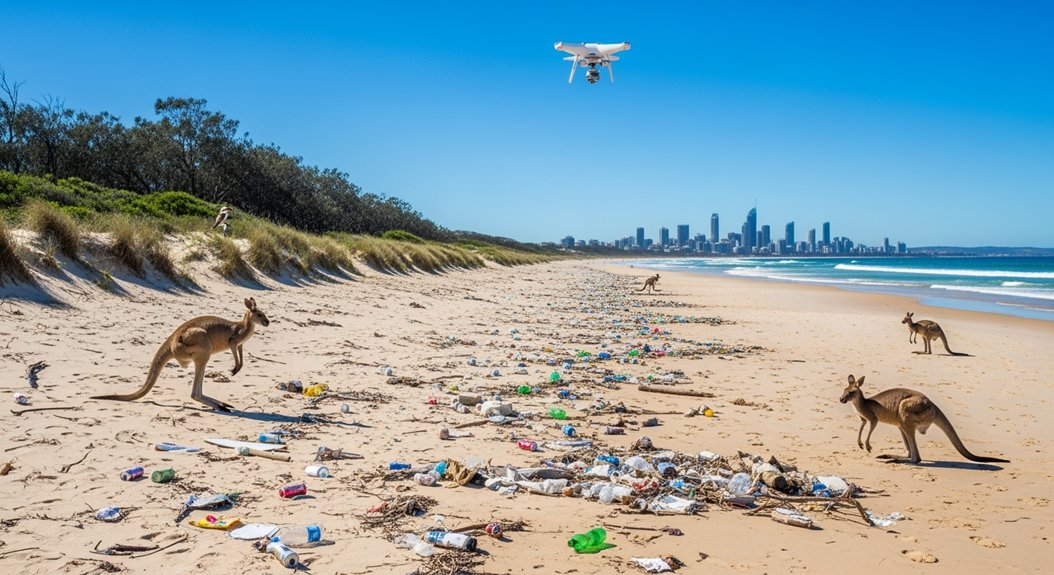Australia experiences an estimated litter volume of about 29 liters per day per 10,000 square meters of publicly accessible land. Plastic constitutes over 80% of this waste, with significant contributions from single-use items and cigarette butts. Coastal and urban areas show varying litter densities, with industrial zones being hotspots. Despite some reductions in recent years, litter remains a pressing environmental issue. Further analysis reveals key sources, geographic distribution, and ongoing efforts to reduce this waste.
Highlights
- Approximately 2 litres of litter are dropped daily per 10,000 m² in surveyed Australian areas.
- Around 29 litter items fall daily per 10,000 m², equivalent to 0.27 items per 1,000 m² each day.
- Plastic accounts for over 80% of litter, with about 130,000 tonnes entering marine ecosystems annually.
- Cigarette butts represent roughly 16% of litter in highways and rural zones, with billions discarded yearly.
- Urban centers, especially in New South Wales, exhibit the highest litter concentrations across Australia.
Daily Litter Volume and Density Across Australia
Across surveyed areas in Australia, the annual litter volume reached approximately 741 litres over 107,677 m², translating to an estimated daily litter volume of around 2 litres per 10,000 m².
Annual litter volume in surveyed Australian areas equates to about 2 litres daily per 10,000 m².
Litter patterns reveal variability across site types, with industrial areas showing the highest density at 12.89 litres per 1,000 m² annually, while beaches recorded the lowest at 1.83 litres per 1,000 m².
Daily estimates based on annual data indicate about 29 litter items per day per 10,000 m², equating to 0.27 items per day per 1,000 m² nationally.
Urban regions consistently exhibit elevated litter densities compared to rural counterparts. This is significant as plastic litter accounts for 71% of beach waste, underscoring the need for focused waste reduction efforts.
These figures derive from selective surveys, emphasizing localized litter accumulation rather than thorough national daily totals.
Such data provide foundational insight into spatial and temporal litter distribution patterns critical for targeted management strategies.
Plastic Litter Trends and Key Contributors
Recent data indicates a 39% reduction in plastic litter along Australian coastlines over the past decade, highlighting progress in waste management strategies. However, the recycling rate for plastics remains critically low at just 13%, indicating substantial room for improvement in waste processing. Single-use plastics, particularly flexible food packaging and wrappers, remain the predominant contributors to litter due to their high consumption and short usage lifespan. Targeted policies and community interventions are essential to address these major sources and sustain downward trends in plastic pollution.
Plastic Litter Reduction
Plastic constitutes over 80% of litter collected in Australia, highlighting its predominance in environmental pollution. Despite this, plastic pollution along coastlines has decreased by 39% over the past decade, aided by community initiatives and advances in recycling technologies. However, recycling rates remain low at 13%, impeding further reduction. Regional trends vary, with decreases in Newcastle and Perth but increases in Hobart. National goals target an 80% reduction in plastic waste entering the environment by 2030.
| Impacted Areas | Emotional Response |
|---|---|
| Coastal ecosystems | Distress over loss |
| Urban waterways | Urgency to act |
| Wildlife habitats | Concern for survival |
Strategic efforts focus on public awareness and regulatory reforms to enhance plastic litter reduction outcomes.
Major Plastic Contributors
Although various materials contribute to litter, over 80% of items collected in Australian surveys are plastic, with approximately 130,000 tonnes entering marine ecosystems annually.
Major plastic contributors include food wrappers, cigarette butts, beverage cans, and flexible packaging, each presenting distinct challenges for waste management.
Factors such as urban runoff, inadequate disposal practices, and socio-economic disparities exacerbate plastic accumulation.
Community engagement and targeted clean-up campaigns have driven regional reductions, particularly in coastal metropolitan areas.
Key points include:
- Food wrappers dominate litter in urban sites like Port Augusta.
- Cigarette butts are prevalent on the Sunshine Coast.
- Beverage cans are common in inland areas such as Alice Springs.
- Flexible plastics remain the most harmful and widespread debris.
Sustained efforts in waste management and public education are critical to further decrease plastic litter nationwide.
Single-Use Item Impact
Single-use items remain a significant source of litter across Australia, contributing disproportionately to environmental degradation despite a nearly 39% reduction in coastal plastic pollution over the past decade.
Flexible plastics, including food wrappers and packaging, constitute approximately 75% of beach litter and pose severe risks to wildlife through ingestion and entanglement.
Consumer behavior, characterized by increased plastic consumption—rising from 123 kg to 147 kg per person between 2010 and 2021—and low recycling rates of 14%, sustains this trend. In total, Australia produces 75 million tonnes of waste annually, highlighting the scale of the challenge.
Key contributors vary regionally, with cigarette butts and beverage cans prevalent in specific inland and coastal areas.
While single use alternatives and policies targeting plastic bans show promise, effective litter reduction requires behavioral shifts toward sustainable consumption and improved waste management to mitigate ongoing environmental impacts and prevent microplastic proliferation.
The Impact of Cigarette Butt Litter Nationwide
Given the annual consumption of approximately 20 billion cigarettes in Australia, the resulting litter of 7 to 8.9 billion cigarette butts poses a significant environmental challenge nationwide.
Cigarette butts constitute about 16% of litter on highways and rural areas and are the most frequently recorded litter item. Their filters, made of cellulose acetate, persist in the environment for over a decade, releasing toxic chemicals and contributing to microplastic pollution.
Key considerations include:
- Toxic leachates harm soil and aquatic ecosystems.
- Persistent plastic filters increase long-term pollution.
- Cigarette butt legislation aims to mandate industry responsibility.
- Recycling initiatives convert butts into usable materials, reducing waste.
Approximately 60% of Australian smokers admit to littering cigarette butts, highlighting the widespread nature of this problem and the need for targeted behavioral interventions to reduce cigarette butt littering.
Policy measures integrating cigarette butt legislation with effective recycling initiatives are critical to mitigate environmental and economic impacts.
Breakdown of Litter by Category and Material
Litter in Australia is mainly composed of takeaway and beverage-related items, accounting for over one-third of roadside litter by number, with confectionery wrappers and straws also significant contributors.
Plastic materials constitute the majority of litter, representing approximately 79% of item density and 70% of volume, primarily through food packaging and beverage containers.
Although cigarette butts are a known environmental concern, their specific proportion within overall litter requires further quantification to assess impact relative to dominant categories. Over 30% of all litter items collected are cigarette butts, making them the most common litter type in Australia cigarette butts prevalence.
Dominant Litter Categories
The predominant categories of discarded items in Australia reveal a complex composition shaped by regional variations and material types.
Litter statistics indicate cigarette butts comprise over 30% of litter nationally, though plastic items dominate in Queensland, constituting about 45% of litter volume.
Paper products also contribute substantially, while glass and metal items are less prevalent but still notable.
The dominant litter types can be summarized as:
- Cigarette butts: over 30% by count but under 1% by volume
- Plastic items: largest by volume, especially in Queensland
- Paper products: significant portion alongside plastic
- Metal and glass: present but lower than national averages
This breakdown reflects regional differences and highlights key targets for litter reduction initiatives.
Plastic Litter Components
Plastic materials constitute a significant majority of litter in Australia, accounting for 81% of all items surveyed according to Clean Up Australia’s 2024 report.
Soft plastics represent 34% of this category, showing a 9% increase, while hard plastics comprise 28%, up 4%. Common items include beverage bottles, caps, lids, and food wrappers, collectively contributing substantial plastic waste.
Small plastic fragments, both soft and hard, dominate litter counts, with densities reaching 804 and 495 items per 1000 m² respectively. These patterns reflect shifts in consumer behavior toward flexible packaging and single-use plastics.
The prevalence of plastic litter, especially in waterways (44% of sites), underscores environmental risks and recycling challenges. The data highlights the need to address plastic waste sources to mitigate growing pollution and microplastic contamination in Australian environments. Australia ranks second globally in single-use plastic waste per capita, emphasizing the urgency to reduce plastic consumption.
Cigarette Butt Impact
Approximately 8.9 billion cigarette butts are discarded annually across Australia, comprising about 16% of all litter items collected, particularly prevalent along highways and rural areas.
Despite declining smoking rates, the persistent volume of butt litter owes to the non-biodegradable cellulose acetate filters that leach toxic chemicals, impacting ecosystems.
Key points include:
- Cigarette butts contribute up to 50% of litter in some regions, prominently in urban and coastal clean-ups.
- Littering rates remain high, with 52% of smokers improperly discarding butts, despite improved public awareness.
- Cigarette recycling initiatives are limited but essential to mitigating plastic pollution.
- Toxic leachates from filters threaten aquatic species and soil health.
These data underscore the need for enhanced cigarette recycling programs and sustained public awareness campaigns to reduce environmental harm.
Geographic Hotspots and Environmental Effects of Litter
Although litter is distributed across Australia, urban centers in New South Wales exhibit the highest concentrations due to dense populations and transport dynamics, with Victoria and Queensland following closely behind.
Litter hotspots are particularly evident in estuarine zones and urban waterways, where mangrove areas act as natural collection points.
Plastic items dominate litter composition, accounting for approximately 79% of items in NSW. The environmental impact of this litter is significant, including biodiversity loss through ingestion and entanglement, habitat degradation, and microplastic pollution affecting aquatic ecosystems.
Plastic waste forms nearly 80% of NSW litter, causing biodiversity loss and aquatic ecosystem damage.
Despite a 51% reduction in litter density and 56% reduction in volume in NSW hotspots from 2021-22 to 2022-23, litter remains widespread, with takeaway waste and beverage containers continuing to contribute substantially to environmental harm.
Progress and Targets in Litter Reduction Efforts
Efforts to reduce litter across Australia have been formalized through specific targets and strategic initiatives at state and national levels. Key litter reduction strategies emphasize measurable goals, policy enforcement, and community involvement.
Notable progress includes:
- Western Australia aims for a 30% litter reduction by 2025, following a 25% decrease from 2015-2020. The state also supports local projects with grants totaling $59,000 to tackle litter at the community level through clean-ups and education campaigns.
- New South Wales targets a 30% plastic litter reduction by 2025 and 60% overall by 2030, supported by $38 million funding.
- NSW exceeded its 2025 plastic litter target with a 54% density reduction since 2018-2019.
- Over 43,000 Western Australian volunteers and community campaigns in NSW enhance public awareness and behavioral change.
These data-driven efforts demonstrate significant advancement while underscoring the need for sustained monitoring and engagement to achieve long-term litter control. Continuous evaluation of litter levels is planned to measure effectiveness and adapt strategies accordingly.
Frequently Asked Questions
What Are the Health Risks Associated With Litter Exposure in Urban Areas?
Litter exposure in urban health increases risks of injury, infection, and allergic reactions. It facilitates pathogen spread via vectors, contaminates soil and water, degrades air quality, and imposes socioeconomic burdens, collectively compromising public health outcomes and wellbeing.
How Does Litter Affect Local Wildlife and Biodiversity in Australia?
Litter substantially threatens wildlife conservation in Australia by causing physical harm, chemical contamination, and habitat degradation. These impacts contribute to biodiversity loss, disrupting ecosystems and reducing species populations, thereby undermining ecological durability and conservation efforts.
What Community Programs Exist for Litter Cleanup and Prevention?
Community programs emphasize community engagement and litter education, mobilizing volunteers through campaigns like Keep Australia Beautiful, organizing local cleanups, and promoting responsible disposal habits, effectively reducing litter and fostering sustained behavioral change in Australian public spaces.
How Is Litter Data Collected and Verified Across Different Regions?
Litter tracking employs hybrid electronic and paper forms, with transect and site information recorded systematically. Data accuracy is guaranteed through standardized protocols like the Australian Litter Measure, paired surveys, and centralized collation by Perth NRM.
What Penalties or Fines Apply for Littering Offenses in Australia?
Littering laws in Australia impose fines ranging from $119 to $5,000 for individuals, with corporations facing higher penalties. Enforcement strategies include on-the-spot fines, court prosecutions, and coordinated efforts by councils and environmental authorities.










